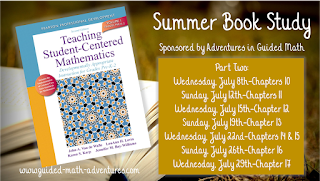Happy Saturday! I am back with thoughts on chapters 3 and 4 from our book study Teaching Student-Centered Mathematics by Van de Walle, Lovin, Karp, and Bay-Williams.
Chapter 3: Assessing Student Learning
In this chapter the focus is on assessment. According to Principles and Standards for School Mathematics (NCTM, 2000) assessment should:
1) enhance children's learning
2) be a valuable tool for making instructional decisions
The authors really stressed throughout this chapter that assessment is not separate from instruction and that children should be informed partners in understanding their progress in learning and how to enhance their growth.
Two major categories of assessment:
1) summative-a cumulative evaluation with a single score (i.e. end of unit test)
The author compared summative assessment to that of a digital snapshot of a single moment.
2) formative- a point in time of understanding, to reassess, or to attempt to identify children's naive understanding and misconceptions and the information is used to provide feedback and make decisions on the next instructional steps
The author compared formative assessment to that of a streaming video...moving pictures demonstrating a child's active thinking and reasoning.
This really painted a clear picture in my head and helped solidify the difference and importance of each!
As we all know, observation is a huge part of the younger grades. While I was reading this chapter I realized just how much I relied on observations to teach me about my students' learning. The author suggested three ways to record observations.
-anecdotal notes
-checklists
-questioning
Tasks were another great way to assess students. Tasks can come in a variety of forms and are most beneficial when they allow the students to explain their thinking and represent their understanding in multiple ways.
The end of the chapter focused on rubrics and how both teachers and students benefit from their use in the classroom. A rubric is a great way for students to see what is expected of them (their level of performance) on any given task. It is not just a grade, but a valuable communication tool that provides feedback on their learning.
Chapter 4: Differentiating Instruction
This chapter focused on differentiating instruction. The author describes differentiation as an instructional approach that requires a shift from focusing on the "middle-of-the-road" child to attending to all children. The author also states that differentiation does not require a teacher to create individualized lessons for each and every child in the classroom.
Differentiation requires emphasizing 3 basic ideas:
1)Planning lessons around meaningful content, grounded in authenticity
2) Recognizing each child's readiness, interest, and approach to learning
3) Connecting content and learners by modifying content, process, product, and the learning environment
The author gave detailed examples of differentiation. As teachers we need to think about a few things before we differentiate. Below are things to consider so we can best meet the needs of our students!
-Do we know our students? What are they interested in? How do they best learn? What is their current knowledge/understanding?
-Do we know what we will differentiate so they can best learn? Should we modify content, process, product, or learning environment?
-Do we know how we will differentiate? Will we use parallel tasks, open questions, learning centers, tiered instructions, small flexible groups?
After reading this chapter I thought back to my own classroom and where I could improve in differentiation. I think I am going to try to incorporate more open questions in my instruction. I just need to remember that open questions can be as easy as giving an answer and asking for the problem, replacing a number in a given problem with a blank or question mark, offering two situations or examples and ask for similarities or differences, and creating a question in which children have to make choices. I think at times I made things too difficult for myself trying to make everything so different. I like the idea of parallel tasks only being changing the numbers in a problem to meet the needs of the various levels of my students. I am sure as the new school year approaches I will have this book close in hand!!
See you Sunday for chapters 5 and 6!!
































